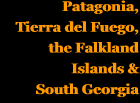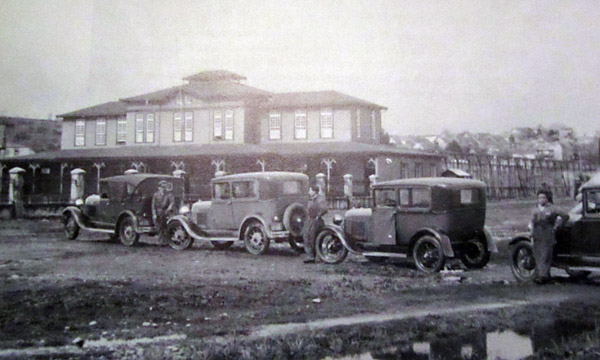 |
|||||||||||||||
 |
|||||||||||||||
 |
|||||||||||||||
 |
|||||||||||||||
General overview Unlike all other chapters of this website, much of the text of the principal pages in this chapter has been taken from our book ‘Railways at the End of the World’, Araucaria Press 2014. The illustrations and other supplementary information are however largely different. The Chilean state railways have their principal track gauges in common with the railways of Argentina, but not a lot else. In contrast to the complex network east of the Andes, the shape of the country has resulted in a network based on single mainlines north and south of Santiago, with a series of branches diverging on either side. The ownership pattern has also been very different, with the principal networks coming under state control as early as the 1870s; yet with a number of important private railways – largely related to Chile’s huge mining industry – some of which continue to run independently to this day. The locomotives, rolling stock and operational methods also differed from Argentine broad gauge practice, owing more to American custom than to British, for example in the use of air brakes and eventually auto-couplers. Generalizing very broadly, the public railways of Chile may be divided into two networks: the Red Norte – ‘northern network’ – of metre gauge and extending northward from La Calera between Santiago and the coast; and the Red Sur – ‘southern network’ though sometimes called the central system – largely though not entirely of 5’ 6” gauge from Valparaiso and the capital southward as far as Puerto Montt. It is the southern end of the Red Sur which concerns us here, within the modern Region XIV de Los Ríos and Región X de Los Lagos, effectively from Lanco southward. As suggested above, this was largely of broad gauge, though with a single metre gauge branch in the formerly independent FC Trasandino por San Martín which is covered in the following chapter. Beyond the broad gauge railhead of Puerto Montt there was also a ferrocarril aislado, an isolated railway, the 60 cm. gauge Ancud to Castro line on the Isla Grande de Chiloé, which was one of five narrow gauge branches opened by the state during the second decade of the 20th century. This has its own separate Chapter 6. The Red Sur grew initially from several independent railways. The FC de Valparaíso a Santiago, and the FC del Sur from Santiago south to Curicó, both began life in the 1850s as privately-owned companies in which the Chilean state had invested. Twenty years later the FC Talcahuano a Chillán was completed, to be followed shortly afterwards by the missing link between Chillán and Curicó. The Chilean government by then had a controlling interest in these southern railways and had embarked on a programme of expansion, only for it to be stalled for over a decade by an economic crash and then by the War of the Pacific against Peru and Bolivia. A lack of co-ordination between the various railway companies proved frustrating during that conflict and with the signing of the Treaty of Ancón in 1883 the government acted quickly to create a new Empresa de los Ferrocarriles del Estado, which came into being on the 4th of January 1884, incorporating all of the state-owned lines. Whilst the common abbreviation EFE has not always been used in the past, it will be adhered to here to distinguish the Chilean state railways from their Argentine equivalents. Obviously these railways were far to the north, for at that time Araucanía and other forested regions south of the Río Biobío were something of a ‘wild south’, though they were to be settled in the latter years of the century, not least by the German immigrants who still give the area around Osorno and Puerto Montt a distinctive character. The railway had reached Collipulli in 1888 but extension further south had to wait until the completion of the 100 m. high Malleco viaduct in 1890, with trains reaching Victoria that same year. José Manuel Balmaceda’s presidency from 1886 to 1891 had seen a renewed enthusiasm for railway construction, and a large number of contracts awarded to the North & South American Construction Co. of New York. However, this was a divisive period in Chilean politics and one which eventually led to the outbreak of civil war and Balmaceda’s suicide. By then the N&SACCo. had gone bankrupt, in June 1890, a circumstance which was to delay construction of several sections of the railway to the south. An appendix page studies the N&SACCO. saga in more detail. Nevertheless, the next section to be completed was that to Temuco in 1893, incidentally passing through the station of Púa, from which later branched to the east the route through Curacautín. This was mentioned in Chapter 3 as part of the only southern Trans-Andine route which has come close to being completed. Beyond Temuco the contractor Benjamín Vivanco took on the task of reaching Pitrufquén. This was completed in November 1898, and brings us close to our particular area of interest. From here southward the work deserves rather more detailed attention. The original station at Puerto Montt. This was demolished after the 1960 earthquake had seriously damaged the structure.
9-3-2018 |
|||||||||||||||
Chapter 5
The south end of the Chilean broad gauge


Main pages
Appendices
4 Pichi-Ropulli Osorno report •
9 Branchline station photos 2 •
11 Barros Jarpa Noel agreement ª
